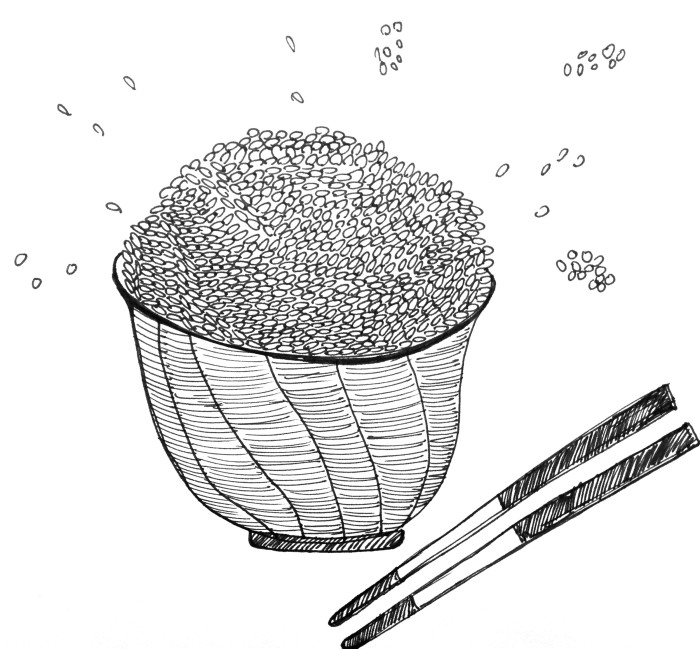cooking rice
by sanae
Before I could walk or crawl my mother carried me on her back while she cooked. I can’t remember this, but I spent hours sleeping against her spine, or watching the burners from above her shoulders. The small kitchen in Paris was our corner of the world, the center of our apartment. Not much has changed today as I sit in the corner of her kitchen, taking notes while she cooks. But I’m restless, so I ask to help. We dice carrots and spring onions, we peel mushrooms, we cook meat on a smoking pan with grated ginger, we quick pickle daikon in plum vinegar, we throw turnips into the miso soup, and we wait for the rice to finish plumping. We always wait for the rice.
Sanaë (SA-NA-E, like “eh”), that’s three syllables. It means rice seedling in Japanese. Written in Japanese it looks like a rice paddy. The first solid food I tasted was brown rice cream. My father milled kilos of rice through a vegetable miller. The smell of rice cooking has a magical effect on my body, it’s a scent I recognize like a creature on a hunt, if I could spray perfume in my kitchen it would be rice scented. The other day I ate a fat daikon radish with miso sauce. The white radish melted on my tongue. I learned it was cooked in the cloudy water from a first rice wash, and then simmered in kombu broth. See, I told you rice is this marvelous thing, and so here is how one makes the perfect bowl of rice.
The Perfect Bowl of Rice
Ingredients:
Two cups short-grain Japanese rice
Water
(If you are a rice fanatic like my mother you might cook your rice with bottled, spring water. I always use tap!)
Note: what truly matters is the ratio of rice to water, so really you could even use a teacup to measure your rice. Two regular cups of rice will make a lot of rice. Two Japanese cups will make a little less. 1 Japanese cup = 3/4 measuring cup.
Directions:
For four hungry individuals (and leftovers for fried rice) measure two cups of short-grain (Japanese) rice. Place rice in a large bowl.
Wash with water, swirling the grains with your fingers, rubbing them lightly. Change the white water with clean water. Repeat a few times. By the end, the water should run almost clear.
Leave the washed rice in a strainer for thirty minutes.
Transfer rice to a heavy pot or a rice cooker. If using a rice cooker, top with two cups plus one tablespoon of water. Press on cook. If using a pot, add 2 1/4 cups of water. Cover. Bring to a boil on high heat, then lower heat to a gentle flame. Cook on low heat for fifteen minutes. Turn off the heat, and keep covered for another fifteen minutes. Do not open the cover! Resist the urge! Then fluff with a wide flat spoon.
If I am running late or need an afternoon snack I will sometimes spoon myself a small bowl of rice, sprinkle soy sauce and add a drizzle of good quality olive oil. If you like the combination, you may also enjoy dipping fresh bread in soy sauce and olive oil. A steaming bowl of rice loves to be covered with gomasio (sesame seeds and salt), slivers of toasted seaweed, or a fried egg, or all of the above. It also likes to be cooked the following day in a smoking hot wok, with toasted sesame oil, spring onions, tiny chopped carrots, and whatever leftover meat you may have in your fridge.
Itadakimasu! Let’s eat!
For a dressed-up, special occasion rice, I recommend you try this recipe:
Takikomi Gohan
Ingredients:
2 cups rice
2 whole large dried shiitake
1 small piece kombu, size of your thumb
2 cup warm water (to soak kombu and shiitake)
1 1/2 tbsp mirin
1 tbsp shoyu
1/4 tsp salt
1 carrot, julienned
1 piece of 2-inch fresh ginger
Directions:
Soak the dried shiitake and kombu in the warm water for ~ 30 minutes. Set aside plump shiitake and kombu. In a saucepan, simmer the shiitake soaking liquid over medium heat. Add mirin, shoyu, salt, carrots, and ginger, and cook for a minute. Set aside the carrots and ginger. Slice shiitake thinly. Pour rice into rice cooker or pot. Add 2 cups of liquid; then add the shiitake carrots, and ginger, and kombu (don’t stir, these stay on top!). Cook following directions for plain white rice. Once ready, fluff up and fold the shiitake, carrots, and ginger into the rice. You can slice the kombu into thin strips and stir it in with the rest.



